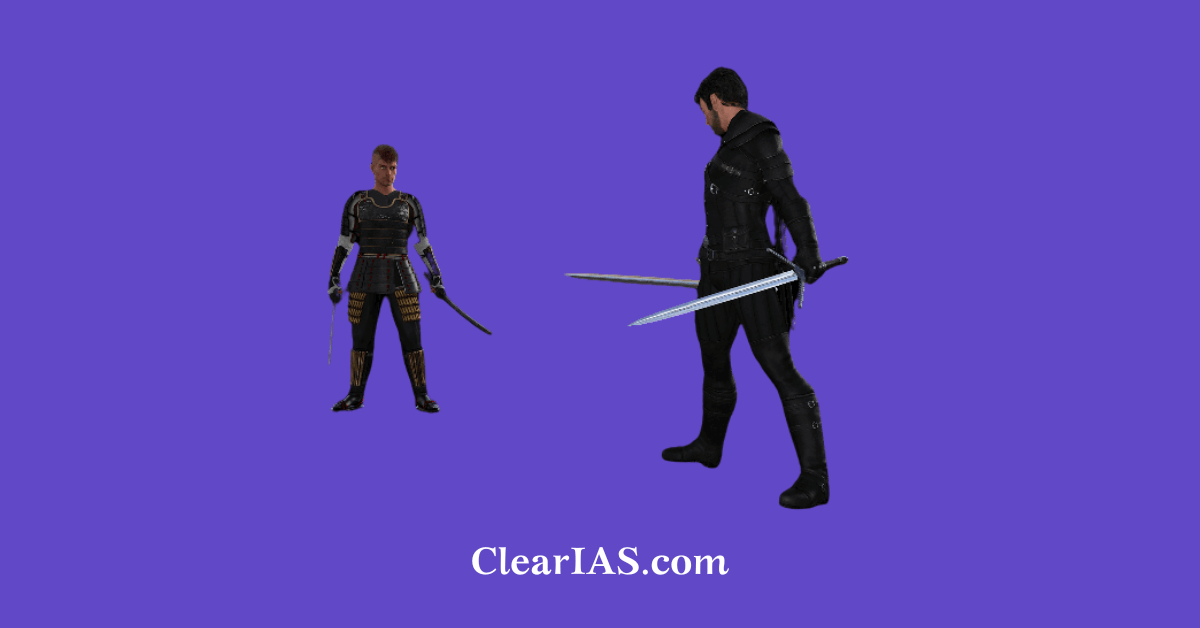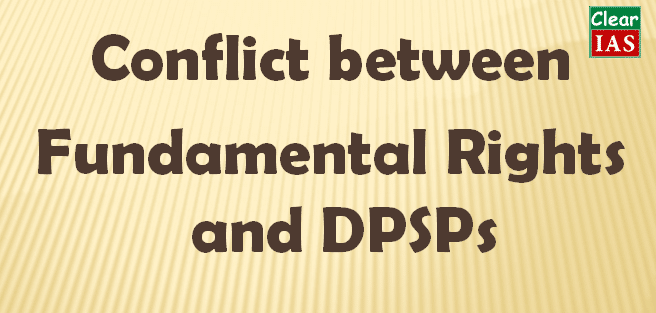
The answer is not as simple as one would think.
There are some important Supreme Court judgements regarding this. We shall see them in detail.
When there is a conflict between Fundamental Rights and DPSPs, which should prevail?
DPSPs are not enforceable by law, but just directives to the state. But when the state tries to implement a DPSP, there can be a conflict between the Fundamental Rights of citizens and DPSP.
In that sense, the conflict between the Fundamental Rights and Directive Principles of State Policy (DPSP) can also be seen as the conflict between the individual and the state.
While Parliament often tried to assert the supremacy of the state and DPSPs over Fundamental Rights, the Supreme Court upheld the rights of the individual as enshrined in the Constitution, by giving appropriate judgments.
Let us study the highlights of a series of court judgments like Champakam Dorairajan Case (1952), Golak Nath Case (1967), Kesavanath Bharathi Case (1973), Minerva Mill Case (1980) etc and see the present status.
Case 1: Kerala Education Bill (1957): Doctrine of Harmonious Construction
Supreme Court in the Re Kerala Education Bill(1957) had propounded the Doctrine of Harmonious Construction to avoid a situation of conflict while enforcing DPSPs and the Fundamental Rights. As per this doctrine, the court held that there is no inherent conflict between FRs and DPSPs and the courts while interpreting a law should attempt to give effect to both as far as possible i. e. should try to harmonize the two as far as possible.
The court further said that where two interpretation of the law is possible, and one interpretation validates the law while other interpretation makes the law unconstitutional and void, then the first interpretation which validates the law should be adopted. But if only one interpretation is possible which leads to conflict between DPSPs and FRs, the court has no option but to implement FRs in preference to DPSPs.
Case 2: Champakam Dorairajan Case (1952)
Court Verdict: All Fundamental Rights are superior over DPSP.
Parliament Reaction: The parliament responded by amending and modifying various FRs which were coming in conflict with DPSPs.
Case 3: Golak Nath Case (1967)
Court Verdict: Fundamental Rights cannot be abridged or diluted.
Parliament Reaction: The parliament responded again by bringing the 25th Amendment Act of the constitution which inserted Article 31C in Part III. Article 31 C contained two provisions:
a. If a law is made to give effect to DPSPs in Article 39(b) and Article 39(c) and in the process, the law violates Article 14, Article 19 or Article 31, then the law should not be declared as unconstitutional and void merely on this ground.
b. Any such law which contains the declaration that it is to give effect to DPSPs in Article 39(b) and Article(c) shall not be questioned in a court of law.
Case 4: Kesavanath Bharathi Case (1973)
The above amendment was challenged in the Kesavananda Bharati Case(1973).
Court Verdict: Parliament can amend any part of Constitution, but could not destroy Basic Structure of the Constitution. The second clause of Article 31C was as declared as unconstitutional and void as it was against the Basic Structure of the Constitution propounded in this case itself. However, the SC upheld the first provision of Article 31C. The court also held that the power of Judicial review cannot be taken out by Parliament.
Parliament Reaction: Parliament brought the 42nd Amendment Act in 1976, which extended the scope of the above first provision of Article 31C by including within its purview any law to implement any of the DPSPs specified in Part IV of the constitutional and not merely Article 39 (b) or (c).
Case 5: Minerva Mill Case (1980)
Court Verdict: A law under Article 31C would be protected only if it is made to implement directives in article 39b and 39 c and not any other DPSPs. The extension to all DPSPs was declared as unconstitutional and void by the SC in the Minerva Mills Case(1980).
Present Order of Precedence
So, if there is a conflict between FR and DPSP, which should prevail? The present order of precedence is as below:
- FR except 14 and 19.
- DPSP 39(b) and 39(c).
- FR 14 and 19.
- DPSP except 39(b) and 39(c).
This means that DPSP 39B and 39C has been given precedence over Fundamental Right 14 (Right to Equality) and Fundamental Right 19 (Freedom of Speech and Expression).
Also, read Indian Polity Notes Which You Shouldn’t Miss!
What is Article 39(b)?
The State shall, in particular, direct its policy towards securing: that the ownership and control of the material resources of the community are so distributed as best to subserve the common good.
What is Article 39(c)?
The State shall, in particular, direct its policy towards securing: that the operation of the economic system does not result in the concentration of wealth and means of production to the common detriment.
Summary of the History of Conflict: Supreme Court vs Parliament

The Supreme Court in the Champakam Dorairajan Vs State of Madras(1951) held that DPSPs cannot override the provisions of Part III of the constitution. As per the judgment, the DPSPs have to run subsidiary to the FRs and have to confirm them.
The parliament responded by amending and modifying various FRs which were coming in conflict with DPSPs. The Supreme court, however, in the Golknath Case(1967) pronounced that parliament cannot amend the FRs to give effect to the DPSPs. The parliament responded again by bringing the 25th Amendment Act of the constitution which inserted Article 31C in Part III. Article 31 C contained two provisions:
a. If a law is made to give effect to DPSPs in Article 39(b) and Article 39(c) and in the process, the law violates Article 14, Article 19 or Article 31, then the law should not be declared as unconstitutional and void merely on this ground.
b. Any such law which contains the declaration that it is to give effect to DPSPs in Article 39(b) & Article(c) shall not be questioned in a court of law.
Later parliament brought the 42nd Amendment Act in 1976, which extended the scope of the above first provision of Article 31C by including within its purview any law to implement any of the DPSPs specified in Part IV of the constitutional and not merely Article 39(b) or (c). However, this extension was declared as unconstitutional and void by the SC in the Minerva Mills Case(1980).
The present position is that only Article 39 (b) and Article 39 (c) can be given precedence over Article 14, 19 and not all the Directive Principles.






Really a great analysis
Can you please site the judgment which states Art 39(b) and 39(c) stands over Art 14 & 19 of the Constitution
SC upheld this first provision of 39(b) & 39(c) in Kesavananda Bharti case, but struck down second position dealing with “Judicial Review”.
great explanation sir….
i want exact role of 39b and c
The article 39(b) of the constitution gives power to the State to direct its policies regarding the ownership and control of material resources of the community and to make policies to help distribute these resources in the best possible way to serve all the people in the community.
The Article 39(c) of the constitution gives power to the state to make changes in the economic system so as to prevent the concentration of wealth and means of production by a person or a small group of people.
Both these articles are used by the state as tools to make policies so that the benefits of economic development and growth is enjoyed by all sections of the people and not just the privilege few.
Since these Articles emphasis more on the common good of the people, they are placed above individual rights defined by Article 14 & Article 19.
Please elaborate article 39(b)and(c)
Hi I am Sanjay Prasad,
PgDCPS student of University of Colombo.
Need some information on Fundamental Rights,so happened to browse through your esteemed site.
Sought a little information.
Thanks,
Thnaks for the article
it means that in case of clash between DPSP & FR the law which abrogate the fundamental right is void except FR in article 14 and Article 19 and the law trying to implement article 39(B) and article 39(c) .
Thnx for news
For better analysis with narrative it is advice to all aspirants to go through oxford campanion politics in india.the chapter the supreme court.
SC upheld this first provision of 39(b) & 39(c) in Kesavananda Bharti case, but struck down second position dealing with “Judicial Review”.
Thank you
My doubt is, say if we want to implement any other DPSP except 39 b and 39 c, which violates A 14 and A 19, do we require constitutional amendment or not?
2. Say we want to implement a DPSP except 39 b and 39 c , and it violates other FR except 14 and 19 (or along with 14 and 19 violates other FRs),will we require constitutional amendment or it is not even possible to do so?
3. Say we want to implement DPSP, 39 b and 39 c which violates 14 and 19, will we require simple act or constitutional amendment?
4. Say we want to implement 39 b and 39 c , which violates A14 and 19 and also other FR, will we require constitutional amendment?
Tq sir
Sir, Really explained well to make to concept crystal clear.
Thanks